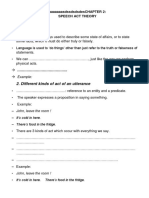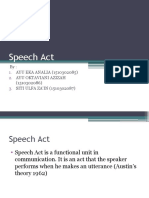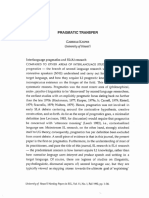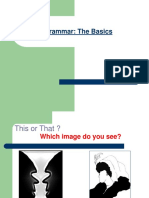0 ratings0% found this document useful (0 votes)
13 viewsPragmatics and Discourse PPT DR
The document discusses speech acts and pragmatics. It defines speech acts as acts performed via utterances, such as apologizing, complaining, or requesting. It also discusses locutionary, illocutionary, and perlocutionary acts. Additionally, it covers topics like indirect speech acts, the cooperative principle, maxims of conversation, and presupposition.
Uploaded by
miranjehanCopyright
© © All Rights Reserved
Available Formats
Download as PDF, TXT or read online on Scribd
0 ratings0% found this document useful (0 votes)
13 viewsPragmatics and Discourse PPT DR
The document discusses speech acts and pragmatics. It defines speech acts as acts performed via utterances, such as apologizing, complaining, or requesting. It also discusses locutionary, illocutionary, and perlocutionary acts. Additionally, it covers topics like indirect speech acts, the cooperative principle, maxims of conversation, and presupposition.
Uploaded by
miranjehanCopyright
© © All Rights Reserved
Available Formats
Download as PDF, TXT or read online on Scribd
You are on page 1/ 21
Discourse and Pragmatics
Dr. Ikhlas M. Hassan
Speech Acts
People perform actions via utterances.
Example:
- (perform the act of ending your employment)
- . (perform compliment )
- . (perform acknowledgement of thanks )
-You're crazy! (perform the expression of surprise )
Actions performed via utterances are generally called
In English, these acts are commonly given more specific labels, such as
apology, complaint, compliment, invitation, promise, or request.
A Speech act is an act which a speaker performs by using an utterance
to communicate .
An utterance usually names three acts, locutionary, illocutionary and
perlocutionary act.
A Locutionary act is the act of simply producing an utterance which
follows the grammatical rules of language.
It is the literal meaning of an utterance which is expressed by the
particular words and structures which it contains.
In other words, it is the performance of an act of saying
something.
An illocutionary act is the act of producing an utterance which serves
to communicate information such as advising, promising, stating,
thanking, warning and so on.
Briefly, it is the performance of an act in saying something.
For example, “I’ll visit you later.” (promise)
A perlocutionary act is the act of producing an utterance which serves
to make something happen such as convincing, deterring, misleading,
persuading, surprising and so on.( the reaction of the hearer)
For example , in I am hungry,
The locution resides in the words being uttered in a grammatical
sequence.
The illocution resides in what the utterance says about the speaker’s
intention. ( it is uttered to make a statement).
The perlocution resides in the effect which the utterance has on the
hearer. It is uttered to make a request for something to eat.
The general functions performed by speech acts are classified into five
types: declarations, representatives, expressives, directives, and
commissives.
Declarations / here the speaker declares a change in the world by
uttering a sentence. Paradigm cases are appointing, bidding, declaring,
nominating, sacking and so on.
a. Priest: I now pronounce you husband and wife.
b. Referee: You're out!
c. Jury Foreman: We find the defendant guilty.
In these examples, the speaker has to have a special institutional role,
in a specific context, in order to perform a declaration appropriately.
Representatives are those kinds of speech acts that state what
the speaker believes to be the case or not.
Sample cases include, statements of fact, assertions,
conclusions, and descriptions, as illustrated in the following:
a. The earth is flat.
b. Chomsky didn't write about peanuts.
c. It was a warm sunny day.
These examples indicate that In using a representative, the
speaker makes words fit the world (of belief).
Expressive/ is a speech act in which the speaker expresses
feelings or attitudes towards a state of affairs using verbs as
thank, apologize, congratulate, and praise, as in:
I am sorry for being late.
Thank you for the nice present!
Directives/ here the speaker tries to make the hearer do something with some
words as, ask , order, command, beg, plead, pray, invite, request, advice, and
demand.
For example;
Please, close the door (an attempt by Speaker to get hearer to do
something.)
Gimme a cup of coffee. Make it black.
Don't touch that.
Commissive/ a commissive is a speech act which commits the speaker to
perform an action in the future. Paradigm cases are offering, pledging,
promising, refusing, threatening, and so on. For example in :
I promise to buy you a present. (Speaker commits him-/herself to the
performance of an action, i.e. promise to do something in the future)
I'll be back. .
I'm going to get it right next time.
There are three basic types of direct speech acts, and they correspond to three
special syntactic structures that seem to occur in most of the world's
languages. We usually use certain syntactic structures with the functions listed
beside them in the following table:
1- If there is no conformity between the structure and the function of
an utterance the result is indirect speech act.
Whenever there is a direct relationship between a structure and a
function, we have a direct speech act.
Whenever there is an indirect relationship between a structure and
function, we have an indirect speech act.
Thus, a declarative used to make a statement is a direct speech act,
but a declarative used to make a request is an indirect speech act.
When it is used to make a statement, it is a direct speech act.
When it is used to make a command/request, it is functioning as an
indirect speech act.
EXAMPLE: It’s cold outside.
Other
Can you pass the salt? (Interrogative structure functions as a request)
2-Indirect speech acts also result where an implicit relationship exists
between the linguistic form and the communicative function of an
utterance.
The utterance lacks a saying verb, but assumes the presence of one, as
in:
I’ll see you tonight. (indirect promise)
3-The use of indirect speech acts help participants to sound more polite
in communication, for example:
- Don’t be late again.(indirect warning).
The Cooperative Principle
ØImplicatures are implicit messages that are inferable in a particular or
general context
ØIn order to make them work, speakers and hearers have to comply
with a basic cooperative principle.
ØThis principle demands that participants should make an important
contribution to the success of conversation.
ØCompliance with this principle helps to reduce misunderstanding in
conversation and achieve rational interaction in communication.
ØCooperative principle : Make your conversational contribution such
as is required, at the stage at which it occurs, by the accepted purpose
or direction of the talk exchange in which you are engaged.
Maxims of the Cooperative Principle
ØThis principle is divided into four sub- principles referred to as maxims.
ØThese maxims constitute the basic rules which participants should
adhere to in any ordinary conversation.
Ø1- Maxim of quantity:
Ø(i) Make your contribution as informative as is required for the current
purpose of exchange.
Ø (ii) Do not make your contribution more informative than is required.
For example, when asked about one’s age, one should simply give the
years.
ØIt is a violation of the maxim of quantity to give further details like the
months, days or minutes. The reason is that the answer is too much.
Ø2-Maxim of quality. Try to make your contribution one that is true.
Ø(i) Do not say what you believe to be false.
Ø(ii) Do not say that for which you lack adequate evidence .
ØFor example, when asked about one’s financial state, one should tell the
truth and say penniless. It is a violation of the maxim of quality to say
millionaire. The reason is that the answer is untrue.
Ø3-Maxim of relation. Be relevant
Ø Speakers should be relevant; what they say must connect suitably with
the rest of conversation.
ØFor example, when asked about somebody’s hairstyle, one’s response
should be on it.
ØIt is a violation of the maxim of relevance to say What is on TV tonight?
The reason is the answer is irrelevant.
Ø4- The maxim of manner
ØBe perspicuous.
Ø(i) Avoid obscurity of expression.
Ø(ii) Avoid ambiguity.
Ø(iii) Be brief.
Ø(iv) Be orderly.
ØFor example, it is a violation of the maxim of manner to utter the
sentence, He left her in tears. The reason is that the sentence is not
clear.
ØIt means either, ‘he was in tears when he left her’
ØOr, ‘ she was in tears when he left her’
Presupposition
A presupposition is something the speaker assumes to be the case prior
to making an utterance
Thus, speakers not sentences have presupposition
For example, Mary’s brother bought three horses.
Presuppositions are:
Mary exists.
Mary has brothers.
Mary has only one brother.
He has a lot of money.
Presupposition is treated as a relationship between two propositions.
a) Mary’s dog is cute
b) Mary has a dog.
c) (a presuppose b)
• Constancy under negation:
a) Mary’s dog isn’t cute.
b) Mary has a dog. (presupposition)
Constancy Under Negation : another example
a) Everybody knows that John is gay.
b) Everybody doesn’t know that John is gay.
c) John is gay. (presupposition)
Types of presupposition
1.Existential
2. Factive
3. Lexical
4. Structural
5. Non-Factive
6. Counterfactual
These types of presupposition are associated with the use of a large
number of words, phrases, and structures.
These linguistic forms are indicators of potential presuppositions,
which can only become actual presuppositions in contexts with
speakers.
1. Existential : Speaker is committed to the existence of the entities named,
not only in possessive constructions, but in any definite noun phrase.
Examples:
The King of France
Your car (you have a car).
2. Factive :Certain verbs or construction indicate that something is a fact.
Verbs:
know, realize, regret
Phrases:
be aware, be odd, be glad
We regret telling him. --> We told him.
She didn’t realize he was ill. --> He was ill.
I’m glad it’s over --> It’s over.
3-Lexical Presupposition: Lexical items ‘start’ , ‘stop’ and ‘again’
have presuppositions inside:
He stopped smoking. >> He used to smoke.
They started complaining. >> They weren’t complaining before.
You are late again. >> you were late before.
4. Structural
In certain sentence structure, part of the structure is already assumed
to be true.
• Good example is wh-question construction in English:
• When did he leave? >> He left.
• Where did you buy the bike? >> You bought the bike.
5. Non-Factive
Is one that is assumed not to be true.(dream, imagine, pretend)
Examples:
• I dreamed that I was rich. >> I was not rich.
We imagine we were in Hawaii. >> We were not in Hawaii.
He pretends to be ill. >> He is not ill.
6. Counterfactual
Meaning that what is presupposed is not only not true, but is the
opposite of what is true, or “contrary to facts.”
• Counterfactual conditional:
• If clauses: If I had enough money, I would buy that house. >> I
do not have enough money
• Embedded clause after wish : They wish they could go on
vacation now. >> They cannot go on vacation now.
Thank You
You might also like
- Ngu Nghia Ngu Dung Hoc Truc Tuyen Week 6No ratings yetNgu Nghia Ngu Dung Hoc Truc Tuyen Week 636 pages
- Eng 429 - Chapter 3 - Discourse and Pragmatics100% (2)Eng 429 - Chapter 3 - Discourse and Pragmatics33 pages
- Disourse and Pragmatics LIN 207 Speech Act Theory: Week 3 of 14No ratings yetDisourse and Pragmatics LIN 207 Speech Act Theory: Week 3 of 1427 pages
- Types of Speech Acts Speech Act Is An Utterance That The Speaker Intends To Affect His/herNo ratings yetTypes of Speech Acts Speech Act Is An Utterance That The Speaker Intends To Affect His/her6 pages
- Speech Act: By: AYU EKA ANALIA (1510302085) Ayu Oktaviani Azizah (1510302086) SITI ULFA ZA'IN (1510302087)No ratings yetSpeech Act: By: AYU EKA ANALIA (1510302085) Ayu Oktaviani Azizah (1510302086) SITI ULFA ZA'IN (1510302087)14 pages
- Ayu Wulandari Rtm-7 - Indirect Speech ActsNo ratings yetAyu Wulandari Rtm-7 - Indirect Speech Acts8 pages
- Pragmatics: Pragmatics Is The Study of How Language Is Used and of The Effect of Context On LanguageNo ratings yetPragmatics: Pragmatics Is The Study of How Language Is Used and of The Effect of Context On Language43 pages
- Blue and Yellow Fun Colorful Trivia Quiz Kids Game Presentation - 20240401 - 132552 - 0000No ratings yetBlue and Yellow Fun Colorful Trivia Quiz Kids Game Presentation - 20240401 - 132552 - 000016 pages
- Comprehensive English Grammar Guide: From Basics to Competitive ExcellenceFrom EverandComprehensive English Grammar Guide: From Basics to Competitive ExcellenceNo ratings yet
- Kachru Braj. - World Englishes and Applied LinguisticsNo ratings yetKachru Braj. - World Englishes and Applied Linguistics18 pages
- Chierchia - Meaning and Grammar An Introduction To Semantics100% (1)Chierchia - Meaning and Grammar An Introduction To Semantics507 pages
- Simon-Vandenbergen, A. M., & Aijmer, K. (2002) .No ratings yetSimon-Vandenbergen, A. M., & Aijmer, K. (2002) .72 pages
- (Contemporary Language Studies) Anthony F. Hartley (Auth.) - Linguistics For Language Learners-Palgrave Macmillan UK (1982) PDFNo ratings yet(Contemporary Language Studies) Anthony F. Hartley (Auth.) - Linguistics For Language Learners-Palgrave Macmillan UK (1982) PDF223 pages
- Full Download Linguistics An Introduction to Language and Communication 6th Edition Adrian Akmajian PDF DOCX100% (1)Full Download Linguistics An Introduction to Language and Communication 6th Edition Adrian Akmajian PDF DOCX45 pages
- Chapter 1: Introduction To Discourse Analysis: 1. Form and FunctionNo ratings yetChapter 1: Introduction To Discourse Analysis: 1. Form and Function5 pages
- Jaszczolt. K - Semantics and Pragmatics - The Boundary IssueNo ratings yetJaszczolt. K - Semantics and Pragmatics - The Boundary Issue37 pages
- روﺪﻗ ةﺪﻧر ، د - ﺪﻤﺣأ ﻦﺑ ﺪﻤﺤﻣ Randa Kaddour, Mohamed BENAHMED ةﺪﻴﻠﺒﻟا ﺔﻌﻣﺎﺟ 2 ﻲﺴﻴﻧﻮﻟ ﻲﻠﻋ) ﺮﺋاﺰﳉا (ﳐ ﱪ ﺎ ادآو ﺔﻴﺑﺮﻌﻟا ﺔﻐﻠﻟا University of Blida 2 Ali lounici-Algeria 1No ratings yetروﺪﻗ ةﺪﻧر ، د - ﺪﻤﺣأ ﻦﺑ ﺪﻤﺤﻣ Randa Kaddour, Mohamed BENAHMED ةﺪﻴﻠﺒﻟا ﺔﻌﻣﺎﺟ 2 ﻲﺴﻴﻧﻮﻟ ﻲﻠﻋ) ﺮﺋاﺰﳉا (ﳐ ﱪ ﺎ ادآو ﺔﻴﺑﺮﻌﻟا ﺔﻐﻠﻟا University of Blida 2 Ali lounici-Algeria 120 pages
- Contoh Verb Noun Adjective Adverb: Believable Is Very ExpensiveNo ratings yetContoh Verb Noun Adjective Adverb: Believable Is Very Expensive10 pages
- The Eight Parts of Speech: List With Definitions and ExamplesNo ratings yetThe Eight Parts of Speech: List With Definitions and Examples3 pages
- On Linguistic Politeness Theory: Robin Lakoff's Theory of Politeness, Brown and Levinson's Theory of Politeness, Geoffrey Leech's Theory of PolitenessNo ratings yetOn Linguistic Politeness Theory: Robin Lakoff's Theory of Politeness, Brown and Levinson's Theory of Politeness, Geoffrey Leech's Theory of Politeness9 pages
- Semantic & Pragmatic: Cooperation and ImplicatureNo ratings yetSemantic & Pragmatic: Cooperation and Implicature10 pages
- Directions: Choose The Letter of The Best Answer. Write The ChosenNo ratings yetDirections: Choose The Letter of The Best Answer. Write The Chosen3 pages
- Disourse and Pragmatics LIN 207 Speech Act Theory: Week 3 of 14Disourse and Pragmatics LIN 207 Speech Act Theory: Week 3 of 14
- Types of Speech Acts Speech Act Is An Utterance That The Speaker Intends To Affect His/herTypes of Speech Acts Speech Act Is An Utterance That The Speaker Intends To Affect His/her
- Speech Act: By: AYU EKA ANALIA (1510302085) Ayu Oktaviani Azizah (1510302086) SITI ULFA ZA'IN (1510302087)Speech Act: By: AYU EKA ANALIA (1510302085) Ayu Oktaviani Azizah (1510302086) SITI ULFA ZA'IN (1510302087)
- Pragmatics: Pragmatics Is The Study of How Language Is Used and of The Effect of Context On LanguagePragmatics: Pragmatics Is The Study of How Language Is Used and of The Effect of Context On Language
- Blue and Yellow Fun Colorful Trivia Quiz Kids Game Presentation - 20240401 - 132552 - 0000Blue and Yellow Fun Colorful Trivia Quiz Kids Game Presentation - 20240401 - 132552 - 0000
- Comprehensive English Grammar Guide: From Basics to Competitive ExcellenceFrom EverandComprehensive English Grammar Guide: From Basics to Competitive Excellence
- Kachru Braj. - World Englishes and Applied LinguisticsKachru Braj. - World Englishes and Applied Linguistics
- Chierchia - Meaning and Grammar An Introduction To SemanticsChierchia - Meaning and Grammar An Introduction To Semantics
- (Contemporary Language Studies) Anthony F. Hartley (Auth.) - Linguistics For Language Learners-Palgrave Macmillan UK (1982) PDF(Contemporary Language Studies) Anthony F. Hartley (Auth.) - Linguistics For Language Learners-Palgrave Macmillan UK (1982) PDF
- Full Download Linguistics An Introduction to Language and Communication 6th Edition Adrian Akmajian PDF DOCXFull Download Linguistics An Introduction to Language and Communication 6th Edition Adrian Akmajian PDF DOCX
- Chapter 1: Introduction To Discourse Analysis: 1. Form and FunctionChapter 1: Introduction To Discourse Analysis: 1. Form and Function
- Jaszczolt. K - Semantics and Pragmatics - The Boundary IssueJaszczolt. K - Semantics and Pragmatics - The Boundary Issue
- روﺪﻗ ةﺪﻧر ، د - ﺪﻤﺣأ ﻦﺑ ﺪﻤﺤﻣ Randa Kaddour, Mohamed BENAHMED ةﺪﻴﻠﺒﻟا ﺔﻌﻣﺎﺟ 2 ﻲﺴﻴﻧﻮﻟ ﻲﻠﻋ) ﺮﺋاﺰﳉا (ﳐ ﱪ ﺎ ادآو ﺔﻴﺑﺮﻌﻟا ﺔﻐﻠﻟا University of Blida 2 Ali lounici-Algeria 1روﺪﻗ ةﺪﻧر ، د - ﺪﻤﺣأ ﻦﺑ ﺪﻤﺤﻣ Randa Kaddour, Mohamed BENAHMED ةﺪﻴﻠﺒﻟا ﺔﻌﻣﺎﺟ 2 ﻲﺴﻴﻧﻮﻟ ﻲﻠﻋ) ﺮﺋاﺰﳉا (ﳐ ﱪ ﺎ ادآو ﺔﻴﺑﺮﻌﻟا ﺔﻐﻠﻟا University of Blida 2 Ali lounici-Algeria 1
- Contoh Verb Noun Adjective Adverb: Believable Is Very ExpensiveContoh Verb Noun Adjective Adverb: Believable Is Very Expensive
- The Eight Parts of Speech: List With Definitions and ExamplesThe Eight Parts of Speech: List With Definitions and Examples
- On Linguistic Politeness Theory: Robin Lakoff's Theory of Politeness, Brown and Levinson's Theory of Politeness, Geoffrey Leech's Theory of PolitenessOn Linguistic Politeness Theory: Robin Lakoff's Theory of Politeness, Brown and Levinson's Theory of Politeness, Geoffrey Leech's Theory of Politeness
- Directions: Choose The Letter of The Best Answer. Write The ChosenDirections: Choose The Letter of The Best Answer. Write The Chosen





























































































